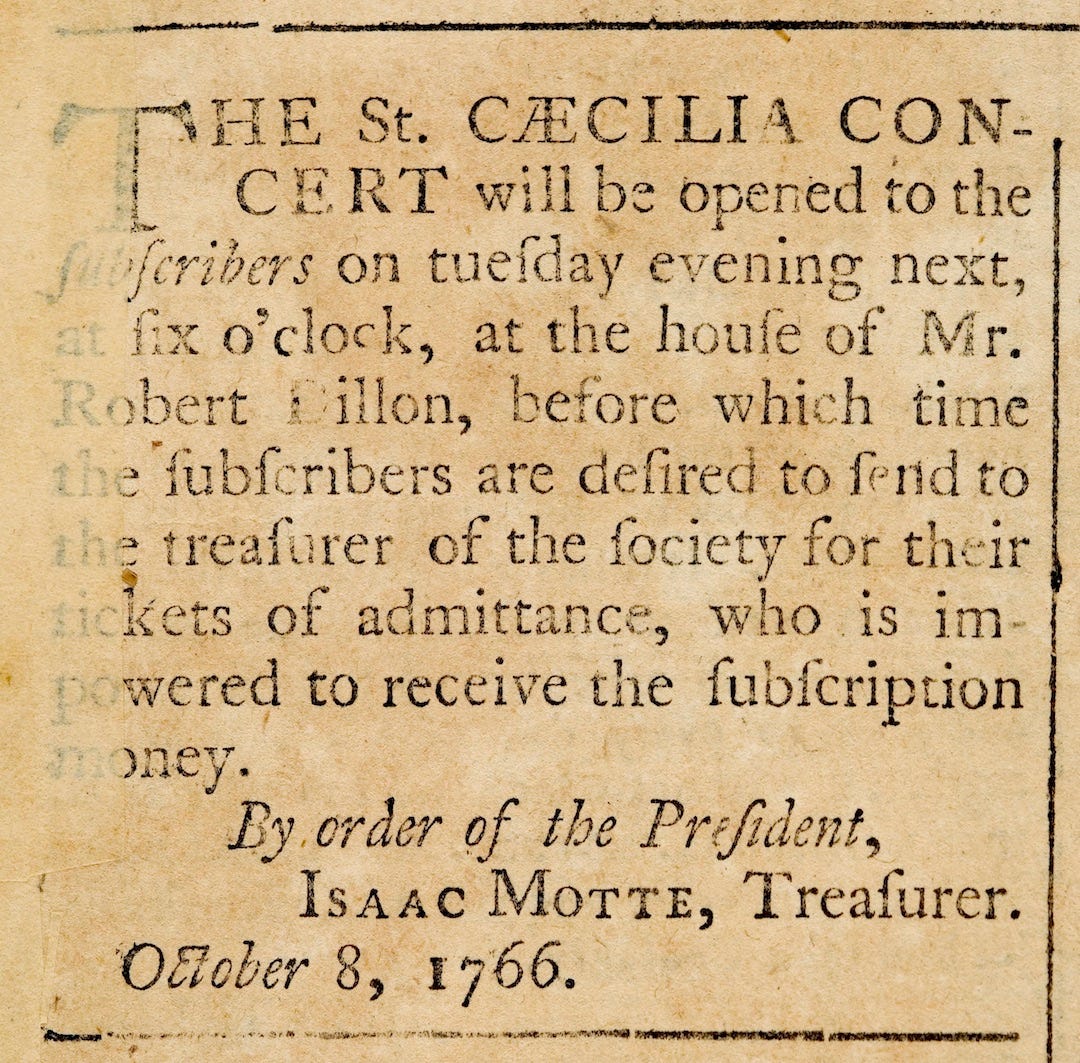#17: Charleston's pineapple fountain, the first orchestra in British America, and the Charleston Time Machine
For South Carolina history lovers far and wide! Enjoy weekly SC history and upcoming SC historical events
Dear reader,
Welcome to Newsletter #17 of The South Carolina History Newsletter! I’m so happy you’re here.
I hope you enjoy today’s newsletter, and as always, please feel free to reply to this email with your ideas and suggestions on South Carolina history you’d like to learn more about. I’m only a click away.
Additionally, please join us & keep the conversation going by becoming a member of our SC History Newsletter Facebook Community here! I can’t wait to meet you.
And now, let’s learn some South Carolina history!
Yours truly,
Kate
(Writing from Greenville, SC)
3 ➳ Upcoming SC History Events
While I have curated the following 3 events below to feature in today’s newsletter, please click here to visit my SC History Events Calendar that organizes all the events I have featured in the newsletter to date, as well as others I have discovered. Please let me know if you’d like to add an event to the list! Reply to this email or send me a note at schistorynewsletter@gmail.com.
I.
March 1-3, 2024 | The Battle for Broxton Bridge | Broxton Bridge Plantation | Ehrhardt, SC | FREE & open to the public to attend
“On the southern end of Broxton Bridge Plantation there is an old battleground, complete with breastworks left over from the South's defenses on February 1, 1865. Relive the last big defensive effort for the Confederates before the battle of Columbia. The special attraction includes the H. L. Hunley submarine traveling exhibit. Battle reenactments on Saturday and Sunday. There'll be a number of exciting activities for the whole family, including Living History Day for schoolchildren starting on Friday.”
II.
Saturday, March 9th from 2:00 - 5:00 pm | “Colonial Times High Tea” | Living History Park | North Augusta, SC | Tickets: $30 per person
“Treat yourself to a one-of-a-kind afternoon with High Tea on Saturday, March 9th at the Red Barn. The event begins at 2 pm and is hosted by the Ladies of the Tavern at the Living History Park. You will be entertained with a talk on The Fashions of the Day and enjoy a delicious high tea menu with tantalizing hot teas, savory delights and sweet treats.”
III.
Sunday, April 28th, 1:00 - 5:00 pm | “GVLMod: Modern Homes Tour of Greenville, SC” | Greenville, SC | Tickets available soon - sign up for updates
“gvlMOD (short for GreenvilleMOD) is a collective of passionate architects, small business owners, and corporate business people with a love of modern architecture, furniture, and design.
Our purpose is to create awareness, provide education, and ultimately preservation of significant structures from the Mid Century era.
The Mid Century era is defined as post-World War II through the early 1970s and the style is characterized by sleek lines, minimal ornamentation, and a blurring of the outside with the inside of the structure. In conjunction with AIA Greenville, we are planning a Mid Century Modern home tour in Greenville in 2023. Any remaining funds, after the tour, we foresee going towards documenting Mid Century Modern homes in the Greenville area for future preservation efforts.”
2 ➳ SC History Fun Facts
I.
What is the story behind Charleston’s pineapple fountain?
While Charleston’s famous Pineapple Foundation was built relatively recently in 1990, the history of the pineapple’s symbol as a sign of hospitality in the city goes back hundreds of years. In colonial times, pineapples were “expensive and difficult to acquire.” The first recorded European encounter with a pineapple was in 1493 on Columbus’ second voyage to the Caribbean region. Columbus returned to Europe with the unusually looking, yet delicious fruit, and it instantly became a cultural hit — so much so that royalty posed with pineapples in official portraits as a sign of luxury and privilege.
In the colonies, demand was high but supplies scarce for the exotic pineapple fruit, and “only the speediest ships could deliver ripe, wholesome pineapples to the confectionery shops of cities such as Charles-town, Boston, Philadelphia, Annapolis, and Williamsburg.”
For a hostess to have a pineapple adorning her dining room table “said as much about her rank in society as it did about her ingenuity.” The fruit was in such high demand that confectionery shops would “rent out” pineapples to households by the day. If a hostess supplied pineapple at a party, it was seen as a true symbol of hospitality and luxury. In this way, the image of the pineapple became synonymous with “gracious home gatherings” in Charleston (and other colonial cities).
Furthermore, legend has it that when sea captains of colonial Charles-town returned home from their travels in the Caribbean Islands, they would spear a pineapple on their home’s fence post to invite their friends and family inside to visit and hear about their adventures. As the “legend of the pineapple grew,” the symbol of the fruit became used in colonial inns as a symbol of hospitality and friendship. You’ll see the motif of the pineapple in Charleston on gateposts, door knockers, and “beautiful serving pieces.”
Though building plans were temporarily thwarted by Hurricane Hugo in 1989, the Riley Waterfront Park in Charleston was completed in 1990, and the iconic Pineapple Foundation resides on the north side of the park as a symbol of the age-old hospitality of Charleston, dating back to colonial times. The foundation was designed by Stu Dawson, Jay Faber, Varoujan Hagopian, and Mark Dawson, of the firm Sasaki.
Did you know that Charleston can boast the first orchestra in North America with its St. Cecelia Society, started in the spring of 1766?
Over 250 years ago, the St. Cecelia Society was founded in Charleston as the first orchestra in British America. It was named after the patron saint of music. The organization is still alive today, but no longer puts on concerts, and is a much more private, low-profile group. In 1766, the St. Cecelia Society was founded as a “subscription concert organization” and for 54 years it sponsored an annual concert series that was “the envy of every other city on the continent.”
Historian Nic Butler (who by the way hosts a great SC history podcast called the Charleston Time Machine - give it a listen!) writes that “one could argue that the roots of every symphony orchestra in the United States can be traced back to this Charleston Society.” In all, Butler estimates that the society hosted more than 400 concerts between 1766 and 1820 for the elite of Charleston. Considering these facts, Butler says “it’s not a stretch to call our St. Cecelia Society the most significant musical institution in the United Stated before the founding of the New York Philharmonic in 1842.”
So why haven’t many people heard of the St. Cecelia Society? First, because the records of the organization burned in the Charleston fire of 1861, and second, because much of the published writing on the history of music in America focuses on the history of music in New England. There is more exciting St. Cecelia history I’d like to share at a later date, but I’m so happy to have discovered this cultural gem of Charleston’s past!
1 ➳ Quote from an SC historical figure
I.
“Charleston is one of the best built, handsomest, and most agreeable cities that I have ever seen. "
—Marquis de Lafayette
Sources used in today’s newsletter:
I always want to improve my work. Answer the poll below to give me your review of today’s newsletter. I also welcome your suggestions for new content! Simply reply to this email with your ideas. Thank you!














